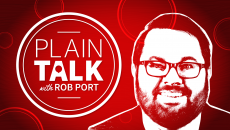What NDSU Could Learn From UND: Don't Let A Bad President Fester

In January University of North Dakota President Robert Kelley will be stepping down, leaving behind him roughly a year on his current contract and an on-campus mess including a budget shortfall, low morale among faculty and staff, and a damaged relationship with students and alumni.
Some Kelley defenders are quick to point to the “Fighting Sioux” nickname turmoil as an excuse, but if anything those storm clouds were probably a benefit for Kelley. They have given him some plausible deniability, allowing him to obscure some of the real problems at the university behind the high-profile nickname fight.
In a perfect world Kelley, who some UND insiders tell me has basically been retired on the job for a while now, probably should have been sent packing some time ago before things got so bad at the university. That’s so much water under the bridge at UND now, but there is a lesson in Kelley’s failure departure for North Dakota State University.
They need to look to the problems with President Dean Bresciani before things get worse.
[mks_pullquote align=”right” width=”300″ size=”24″ bg_color=”#ffffff” txt_color=”#000000″]”If the authority of Chancellor Hagerott is going to be preserved, he and the Board will have to assert some leadership by telling Bresciani — and every other college president — to get with the concept of a university system or get lost,” Omdahl continues.[/mks_pullquote]
There’s no question that Bresciani was a bad hire for NDSU. He took over after the debacle that was the Joe Chapman era at NDSU, and he’s done little to improve the situation. Bresciani consistently works to keep lawmakers, those responsible for his budget, at arm’s length when it comes to decisions which impact that budget. He accuses lawmakers of underfunding his institution even as he used a university-owned private airplane to fly back and forth to Bismarck. More recently it was revealed that Bresciani was using a member of the university police force as his personal security guard and chauffeur.
That these maneuvers are utterly tone deaf, and do a great deal to hurt NDSU’s credibility with both the public and state policymakers, is apparently lost on Bresciani.
And let’s not forget that Bresciani was one of the architects of much of the turmoil over leadership which has engulfed the university system. Former chancellor Hamid Shirvani attempted to pursue his mandate to be a “CEO style” leader for the university system, but was sent packing when Bresciani, Kelley, and former Minot State University President David Fuller organized a campaign to undermine him. Things got so ugly that Shirvani said someone vandalized his home with feces.
I can’t confirm Shirvani’s claim, and certainly there’s no evidence that Bresciani was directly involved, but he certainly helped create an atmosphere of hostility to Shirvani’s attempts to lead.
And now it seems as though Bresciani is set to square off with another chancellor. Mark Hagerott, who took over that job earlier this year, told me during an interview in September that one of his goals is to restore trust in the university system. And, indeed, when Bresciani announced that he wants to inflate his school’s enrollment to 18,000 students – a nearly 25 percent increase in the next five years for a school where enrollment grew less than 1 percent to over the previous five years – Hagerott gently echoed the sentiments of state lawmakers by suggesting that NDSU might have better priorities like retention and graduation rates for the students the school already has.
Bresciani responded with a forceful column in the state’s newspapers dismissing both Hagerott and state lawmakers. “At North Dakota State University, we’ve heard the message loud and clear and will do our part by raising enrollment to 18,000 students over the next five years,” he wrote. Note the use of the word “will.” As in, NDSU is going ahead despite the reservations of Hagerott and state lawmakers.
That, in a nutshell, is Bresciani’s problem. He seems to think he operates outside of the state’s chain of command. I don’t often find myself agreeing with former Lt. Governor Lloyd Omdahl, a liberal observer and long-time higher education insider, but he got it right on Bresciani in his column this week. “To prove that he was a team player, Bresciani could have let the chancellor have the last public word and discussed their differences off-camera,” he wrote. “Instead, he chose to push back in the newspapers. Apparently, he doesn’t want to be a team player.”
“If the authority of Chancellor Hagerott is going to be preserved, he and the Board will have to assert some leadership by telling Bresciani — and every other college president — to get with the concept of a university system or get lost,” Omdahl continues.
I think, when it comes to Bresciani, it may be time to focus on the “get lost” part. The poor perception he has created with the public, and the hostile relationship he has cultivated with lawmakers, are both beyond repair. Not that Bresciani seems interested in repairing them.
So maybe it’s time to let Bresciani go away. A transition wouldn’t be that hard. His current contract entitles him to his more than $330,000 per year salary through June 30 of 2016.
Maybe the state should decline to renew that contract and let Bresciani go be a human toothache at some other university.




